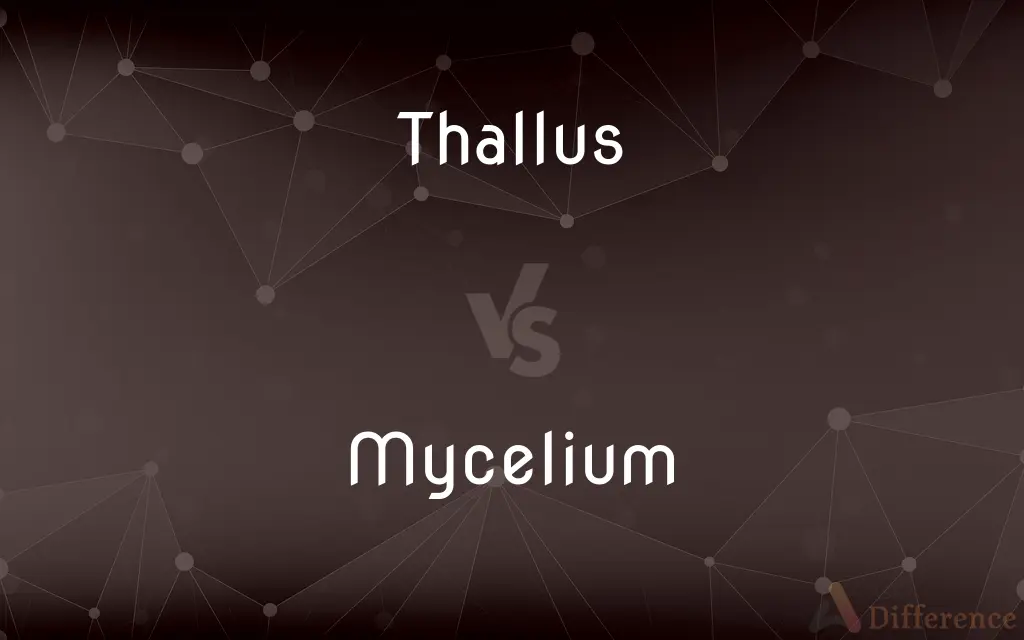Thallus vs. Mycelium — What's the Difference?
Edited by Tayyaba Rehman — By Urooj Arif — Updated on March 28, 2024
Thallus is a plant body without true stems, leaves, or roots, found in algae and fungi, while mycelium is the network of fungal filaments (hyphae) vital for growth and nutrient absorption.

Difference Between Thallus and Mycelium
Table of Contents
ADVERTISEMENT
Key Differences
A thallus represents the entire body of algae, lichens, and some fungi, lacking true roots, stems, or leaves, serving both structural and functional purposes. On the other hand, mycelium specifically refers to the mass of hyphae in fungi, acting as the main mode of vegetative growth and playing a crucial role in nutrient absorption and reproduction.
Thalli can vary greatly in form, ranging from simple, undifferentiated masses to complex structures resembling leaves and stems. Mycelium, however, always consists of thread-like structures that branch and form a network beneath the soil or within the host body.
The thallus is often involved in photosynthesis, especially in algae and lichens, where it forms the main body for light absorption and conversion into energy. Conversely, mycelium is primarily concerned with nutrient absorption from the environment, decomposing organic material for energy.
Reproduction in organisms with a thallus can be involving various structures for dispersal. In contrast, mycelium contributes to fungal reproduction by producing spores, either directly or by forming specialized structures like mushrooms.
The environment and habitat of thallus-bearing organisms can be quite diverse, from aquatic to terrestrial, depending on the species. Mycelium typically thrives in moist, dark environments, often within soil or decaying organic matter, showcasing a more specific habitat preference.
ADVERTISEMENT
Comparison Chart
Definition
The body of algae, lichens, and some fungi, lacking true roots, stems, or leaves.
The mass of hyphae in fungi, serving as the growth and nutrient absorption system.
Structure
Can vary from simple masses to complex leaf-like forms.
Consists of thread-like structures forming a network.
Primary Function
Involves photosynthesis in photosynthetic species; structural.
Focused on nutrient absorption and decomposition.
Reproduction
Can be with various dispersal structures.
Produces spores, either directly or via specialized structures.
Habitat
Diverse, including aquatic and terrestrial environments.
Prefers moist, dark environments, like soil or decaying matter.
Compare with Definitions
Thallus
A simple plant body without distinct stems, roots, or leaves, often found in algae.
The green, leafy mats of algae covering the pond's surface are actually thalli.
Mycelium
The vegetative part of a fungus, consisting of a network of fine white filaments (hyphae).
The mycelium threads through the forest floor, decomposing leaf litter.
Thallus
The body of a lichen, comprising fungal and algal components.
The thallus of the lichen clung tightly to the tree bark.
Mycelium
The hidden part of fungi that can spread extensively beneath the soil surface.
The mycelium of this species can extend for miles.
Thallus
A non-differentiated plant body, characteristic of lower plant forms.
Researchers study the thallus structure to understand primitive plant evolution.
Mycelium
The underground part of mushrooms, absorbing nutrients from the environment.
The mycelium connects trees in a forest, facilitating nutrient exchange.
Thallus
A term used to describe the overall morphology of certain fungi.
The thallus of this fungus spreads across the log, absorbing nutrients.
Mycelium
A mass of fungal hyphae that is crucial for the fungal lifecycle.
Scientists study mycelium to develop new antibiotics.
Thallus
In botany, a plant body that is not organized into true stem, root, or leaf structures.
Botanists examine how the thallus participates in photosynthesis and nutrient uptake.
Mycelium
In fungi, the main body responsible for absorption and growth.
The mycelium grows rapidly, exploiting the nutrients in its environment.
Thallus
Thallus (plural: thalli), from Latinized Greek θαλλός (thallos), meaning "a green shoot" or "twig", is the vegetative tissue of some organisms in diverse groups such as algae, fungi, some liverworts, lichens, and the Myxogastria. Many of these organisms were previously known as the thallophytes, a polyphyletic group of distantly related organisms.
Mycelium
Mycelium is the vegetative part of a fungus or fungus-like bacterial colony, consisting of a mass of branching, thread-like hyphae. The mass of hyphae is sometimes called shiro, especially within the fairy ring fungi.
Thallus
A plant body undifferentiated into stem, root, or leaf.
Mycelium
The vegetative part of a fungus, consisting of a mass of branching, threadlike hyphae.
Thallus
The main body of an alga, fungus, or lichen.
Mycelium
A similar mass of fibers formed by certain bacteria.
Thallus
(botany) An undifferentiated plant body, such as in algae.
Mycelium
The vegetative part of any fungus, consisting of a mass of branching, threadlike hyphae, often underground.
Thallus
(botany) Any plant body lacking vascular tissue.
Mycelium
The white threads or filamentous growth from which a mushroom or fungus is developed; the so-called mushroom spawn.
Thallus
A solid mass of cellular tissue, consisting of one or more layers, usually in the form of a flat stratum or expansion, but sometimes erect or pendulous, and elongated and branching, and forming the substance of the thallogens.
Mycelium
The vegetative part of a fungus consisting of a mass of branching threadlike hyphae
Thallus
A plant body without true stems or roots or leaves or vascular system; characteristic of the thallophytes
Common Curiosities
What is a thallus?
A thallus is the body of certain plants and algae that lacks distinct stems, roots, or leaves.
How does the structure of thallus and mycelium differ?
The thallus can vary in form, resembling leaves and stems in some cases, while mycelium is always a network of thread-like hyphae.
What is the primary function of mycelium?
The primary function of mycelium is nutrient absorption and decomposition of organic materials.
Where can thallus-bearing organisms be found?
They inhabit diverse environments, including both aquatic and terrestrial ecosystems.
Do all thalli look the same?
No, thalli can vary greatly in appearance, from simple, undifferentiated masses to complex structures that mimic leaves and stems.
What is the preferred habitat of mycelium?
Mycelium typically prefers moist, dark environments such as soil or decaying organic matter.
Are thalli found in all fungi?
Not all fungi have thalli; this term is more commonly associated with certain lower plant forms, algae, and lichens.
Is mycelium harmful to plants?
Mycelium is not inherently harmful and can actually benefit ecosystems by decomposing dead material and facilitating nutrient cycling. However, some fungal species can cause plant diseases.
What is mycelium?
Mycelium is the network of fungal filaments (hyphae) important for nutrient absorption and growth in fungi.
Can thalli perform photosynthesis?
Yes, thalli in algae and lichens perform photosynthesis, converting light energy into chemical energy.
How do organisms with a thallus reproduce?
They can reproduce, using various structures for dispersal.
How does mycelium contribute to an ecosystem?
It plays a crucial role in nutrient recycling, breaking down organic matter, and sometimes forming symbiotic relationships with plants.
What role does mycelium play in fungal reproduction?
Mycelium produces spores, either directly or by forming specialized structures like mushrooms, for reproduction.
Can mycelium be seen with the naked eye?
While individual hyphae are microscopic, the mycelium network can often be seen with the naked eye, especially when it forms a dense mat.
Can the thallus of a plant be considered its organ?
The thallus is not considered an organ in the traditional sense because it lacks the differentiated structures found in higher plants, such as true leaves, stems, and roots.
Share Your Discovery

Previous Comparison
Nickel vs. Chrome
Next Comparison
Degradation vs. HumiliationAuthor Spotlight
Written by
Urooj ArifUrooj is a skilled content writer at Ask Difference, known for her exceptional ability to simplify complex topics into engaging and informative content. With a passion for research and a flair for clear, concise writing, she consistently delivers articles that resonate with our diverse audience.
Edited by
Tayyaba RehmanTayyaba Rehman is a distinguished writer, currently serving as a primary contributor to askdifference.com. As a researcher in semantics and etymology, Tayyaba's passion for the complexity of languages and their distinctions has found a perfect home on the platform. Tayyaba delves into the intricacies of language, distinguishing between commonly confused words and phrases, thereby providing clarity for readers worldwide.
















































